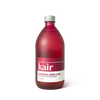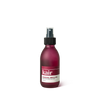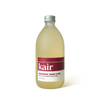How to wash and store outerwear
As the nights draw in, and a wintry chill arrives, it’s time to dig out your cosiest cold-weather outerwear and get it reacquainted with the outdoors. Whether that be a chill-proof woollen winter coat to keep you warm in style, or a fluffy plaid jacket to brighten up the darkest of days, all you need is a little TLK (tender, loving, Kair) to protect them from the wind, rain and mud. After all, no matter what kind of coat-wear you are, Kair is for all. Read on to discover our top tips for extending the life of your favourite winter pieces, to keep you - and your outerwear - looking and feeling good season after season.
Down jackets, parkas, puffer coats
Always check the care instructions on the label of your coat, but as a general rule, both nylon and puffy, down-filled jackets, coats and vests can all be safely machine washed.
Opt for a cool wash (no more than 30ºC) and a gentle cycle with a low spin (check out our definitive washing machine cycles guide). After washing, gently squeeze out as much water as possible by hand before hanging to dry (avoid both wringing and tumble drying, which can cause damage to the fibres). Be sure to dry it in a cool, dry place - otherwise it may begin to smell. While it’s still drying, take it off the hanger every 30 minutes or so to fluff it up and redistribute the filling by giving it a gentle shake and massaging the fibres. Repeat this ‘fluffing up’ process until your coat’s completely dry.

Woollen coats
Woollen coats require extra Kair if you want to avoid shrinkage. Most can be safely machine washed, unless they’re heavily embellished (see our guide on mastering the wool wash). Just be sure to select the wool or handwash cycle (low temperature, short cycle, gentle spin), and opt for specialist detergents like our Wool, Silk and Delicates Wash over regular enzyme-based ones (which will destroy the protein in the wool). Take your coat out of the drum immediately after washing to reduce wrinkling and creasing, and gently press or squeeze the water out (never wring). Reshape it if necessary while damp, then leave to dry on a flat surface - never hang wet wool. Avoid tumble dryers, as well as direct heat sources like sunlight or radiators, as these can damage and shrink the fibres.

Fleece jackets
Wash your fleeces in the same way as down and puffer jackets - in a washing machine, on a cool and gentle cycle. Just be sure to turn them inside out if you want to reduce lint or pilling (which happens when the fibres become loose and tangle together, forming little bobbles on the surface). Avoid washing with materials like cotton as well - the friction can again make your fleece linty and pilled, and even less water-resistant. For the same reason, avoid using fabric conditioner on waterproof fleeces specifically: fabric conditioner creates a thin, protective layer over each fibre, which can clog the fabric’s pores and so reduce a material’s absorbency, making it less effective (check out our ultimate guide to fabric conditioner). As with down jackets, hang to air dry. And again, check the care instructions: some fleeces contain dyes, which require additional and specialist care.

Leather, suede, furs, velvet
Most of the time, it’s better to wash your outerwear at home than go to the dry cleaner (see our article on whether or not to dry clean). But certain fabrics must always be dry cleaned, including leather, suede, furs and velvet, which are vulnerable to losing their texture, or losing their shape if there’s a mixture of different fabrics in the facings and linings.
Hang and store carefully
For coats made of natural materials, such as down, wool, leather and suede, we recommend hanging them on sturdy wooden hangers (like these natural ones from Ikea), to help them retain their shape and remain wrinkle-free. Store them somewhere dry, dark, clean and cool (around 18ºC), to prevent moisture build-up, mould, and damage from sunlight. If you’re tight on hanging space, you can pop nylon coats and fleeces in plastic containers, then tuck them away in a drawer or under your bed away from heat and light. Puffer coats made from polyfill, as opposed to down feathers, can also be squished down to half their size and stored in vacuum storage bags (we love this one from Lakeland).
Top tips before washing
TIP #1: Wash similar fabrics together to avoid pilling, fading or degradation.
TIP #2: Zip up zips to prevent snagging, but leave buttons unbuttoned.
TIP #3: Check your coat pockets for tissues, keys, coins and other metal items.
TIP #4: Unless it’s heavily soiled, only wash your outerwear at the end of the season.
TIP #5: To freshen between washes, spot-treat any stains and spritz with finishing spray.
Cover image by The Spruce


















